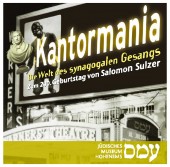On the occasion of the Salomon Sulzer bicentennial the Jewish Museum Hohenems will present an exhibition about the life and artistic careers of Jewish cantors, exploring tensions and productive relations between tradition and contemporary, individual expression, liturgy and art, rabbi and community, Jewishness and a Christian or secular environment.
Starting from the impact of Salomon Sulzer both on Jewish liturgy and his (not always Jewish) audiences, on the historical development of reform Judaism in Europe and the US and changes in musical style we want to confront different biographies, spanning from duty to dream, profession to individual determination. Cantors like the Lewandowskis from Berlin and Samuel Naumbourg from Paris, Gershon Sirota or Yossele Rosenblatt, as well as the Jazz-Singer Al Jolson or the tenor from the Metropolitan Opera, Richard Tucker, the last cantor of Hohenems Harry Weil or Roman Cykowski of the Comedian Harmonists, David Buzaglo from Marocco and female Cantors of today alike will be the subject of this exhibit.
Salomon Sulzer, who made his way from the syngaogue of Hohenems to the temple in Vienna, one of the centers of Jewish life and culture in 19th century Europe, became a “star” of public life, both for Jews and Non-Jews alike. He made friends with Franz Schubert and impressed his audiences during the “Schubertiade”. His appeal made even non-Jews visit the temple, in order to listen to his voice.
The former synagogue of Hohenems, the home of both Salomon Sulzer and the famous Hohenems Rabbi Aron Taenzer, abused as the fire brigade building for more then 40 years, will be restored soon and opens for the public as a music school again next year. Already on October 17 the Jewish Museum will celebrate Salomon Sulzer with an international cantor’s concert in the new Salomon Sulzer auditorium in the restored synagoge building. More concerts and film screenings, accompanying the exhibition, will follow at different locations.
Curator:
Hannes Sulzenbacher (Wien)
Research:
Christian Kloesch (Wien)
Design:
stecher id (Götzis)
Roland Stecher und Thomas Matt
Museum education:
Helmut Schlatter (Hohenems)
Secretary:
Renate Kleiser



